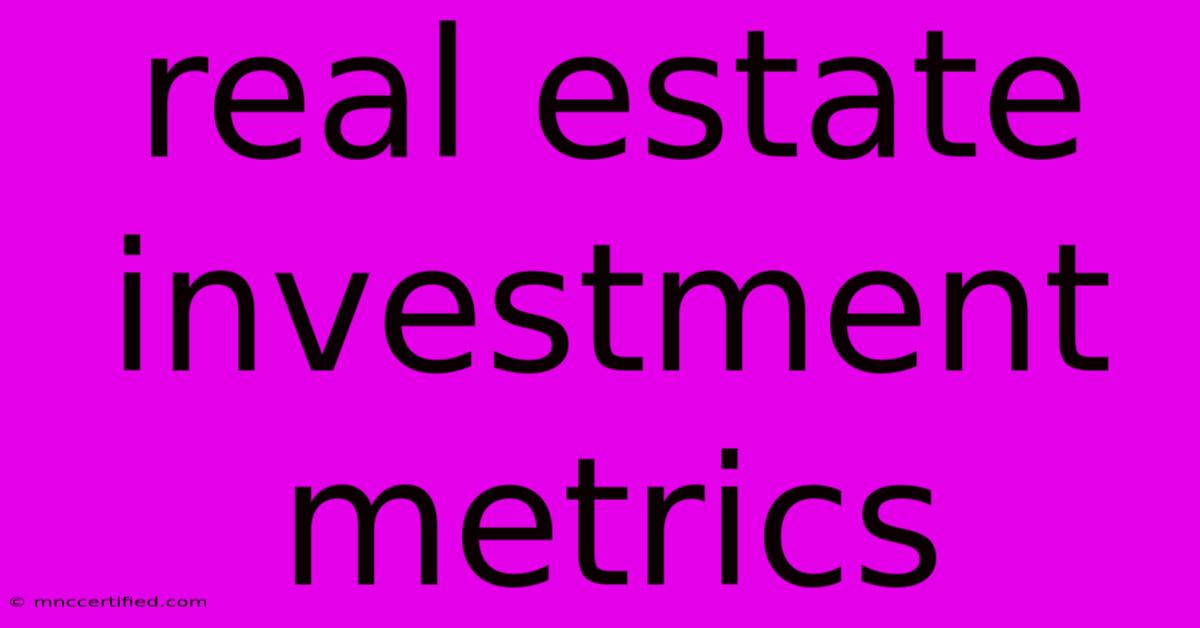Real Estate Investment Metrics

Table of Contents
Mastering Real Estate Investment Metrics: A Comprehensive Guide
Investing in real estate can be incredibly lucrative, but success hinges on understanding and effectively using key performance indicators (KPIs). Ignoring crucial metrics can lead to poor investment decisions and significant financial losses. This comprehensive guide will equip you with the knowledge to analyze real estate opportunities effectively, using a variety of metrics to make informed choices.
Key Real Estate Investment Metrics Explained
Several metrics are essential for evaluating the profitability and risk associated with a real estate investment. Let's explore some of the most important:
1. Capitalization Rate (Cap Rate)
The cap rate is a crucial metric indicating a property's potential return on investment based on its net operating income (NOI). It's calculated as:
Cap Rate = NOI / Property Value
A higher cap rate generally suggests a better investment opportunity, assuming all other factors are equal. However, a high cap rate might also indicate higher risk. Understanding the market and the property's specifics is crucial for proper interpretation. Remember to consider factors such as market conditions and potential for appreciation when analyzing the cap rate.
2. Net Operating Income (NOI)
NOI represents the property's income after operating expenses are deducted but before debt service (mortgage payments) and taxes. It's calculated as:
NOI = Revenue - Operating Expenses
Operating expenses include property management fees, insurance, property taxes, utilities, and repairs. Accurately calculating NOI is vital for determining the property's profitability and for other crucial metrics like the cap rate. Thoroughly investigate all potential expenses when calculating NOI to avoid inaccurate projections.
3. Cash on Cash Return (CoC Return)
This metric measures the annual return on your initial cash investment. It’s particularly important for investors using significant leverage (mortgages). The formula is:
CoC Return = Annual Before-Tax Cash Flow / Total Cash Investment
The total cash investment includes the down payment, closing costs, and any initial repairs or renovations. A higher CoC return indicates a more efficient use of your initial capital. This metric is especially useful for comparing different investment properties with varying levels of financing.
4. Return on Equity (ROE)
ROE measures the profitability of an investment relative to the equity invested. This is similar to CoC Return but considers the overall equity position, including appreciation in value.
ROE = Net Income / Equity
Net income considers both cash flow and appreciation (or depreciation) of the property's value over the period considered. It’s a longer-term view than the CoC return.
5. Debt Service Coverage Ratio (DSCR)
DSCR assesses a property’s ability to meet its debt obligations. Lenders use this metric heavily to assess risk. It’s calculated as:
DSCR = NOI / Annual Debt Service
A DSCR greater than 1.0 indicates that the property generates enough income to cover its mortgage payments. A higher DSCR is preferable, providing a safety cushion against unexpected expenses or income shortfalls. Lenders typically require a minimum DSCR, often 1.2 or higher.
Beyond the Numbers: Qualitative Factors
While quantitative metrics are vital, don't neglect qualitative factors:
- Location: Consider neighborhood growth, proximity to amenities, and overall market trends.
- Property Condition: Thorough inspections are essential to identify potential repair costs.
- Tenant Quality: Stable, long-term tenants contribute to consistent income.
- Market Analysis: Research comparable properties and understand local market dynamics.
Utilizing Metrics for Informed Decisions
Mastering these real estate investment metrics allows you to:
- Identify profitable opportunities: Quickly assess the potential return of different properties.
- Negotiate better deals: Use data to support your offers and identify undervalued properties.
- Manage risk effectively: Understand the financial implications of your decisions.
- Track performance: Monitor your investments and make adjustments as needed.
By consistently applying these metrics and incorporating qualitative factors, you can significantly increase your chances of successful real estate investment. Remember that consistent learning and adapting to market changes are crucial for long-term success in the dynamic world of real estate.

Thank you for visiting our website wich cover about Real Estate Investment Metrics. We hope the information provided has been useful to you. Feel free to contact us if you have any questions or need further assistance. See you next time and dont miss to bookmark.
Featured Posts
-
Ceasefire Reached Israel Hezbollah
Nov 28, 2024
-
Inter American Investment Corp
Nov 28, 2024
-
Mishal Husains Bbc Exit Confirmed
Nov 28, 2024
-
177m Euro Millions Win Uk Player
Nov 28, 2024
-
Real Madrid Vs Liverpool Champions League Final Score
Nov 28, 2024